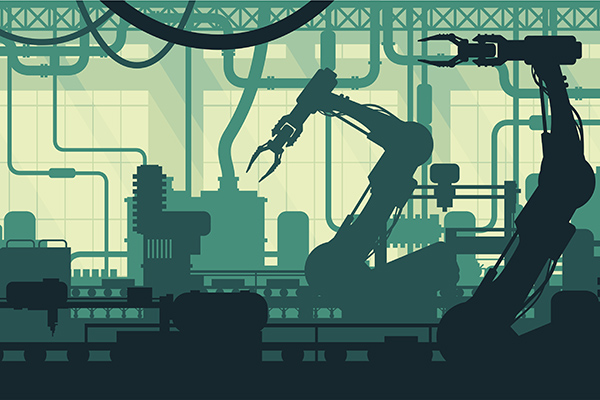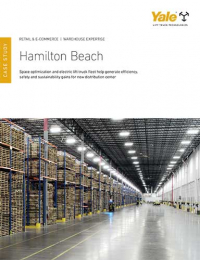Other Voices: Five ways to use robotics in the warehouse
The potential benefits of robotics and automation in the warehouse must be balanced with concern about potential logistical hurdles.

Editor’s note: The following column by Evan Hammersley, warehouse automation and robotics product manager for NITCO, is part of Modern’s Other Voices column, a series featuring ideas, opinions and insights from end-users, analysts, systems integrators and OEMs. Click here to learn about submitting a column for consideration.
As robotics and automation continue to grow in popularity, innovative warehouse automation trends are steadily being implemented in warehouses and distribution centers around the world. This new industry phenomenon is optimizing efficiencies and workflows across all areas of operations, and many managers are reporting a return on their investments in as little as six months.
But not all tasks and duties are well suited for robots – some are simply better left to the human workforce. Finding the right mix of robotics and people in your warehouse is the key to success and increased profits. To help you strike that perfect balance of automation and good old-fashioned labor, we have highlighted the four best ways to use robotics and automation in the warehouse setting.
Inventory management
To err is human. But small errors can cause big problems when it happens in a warehouse. One job area where people are susceptible to simple mistakes is doing repetitive tasks and manual entry. If consistent errors are resulting in lost time from barcode scanning or human-made data entry, consider automating these processes to improve accuracy and efficiency.
Warehouses typically rely on one of two types of automated scanning: camera-based and laser scanners. Camera-based scanners are more cost effective and can provide an image of the entire barcode even if the code itself is damaged or partially covered. Laser-based scanning technology is best suited to scan barcodes on flexible polybags (or any other odd-shaped packaging) and are usually easier and less time consuming to set up than camera-based scanners.
Beyond the accuracy factor, automated and robotic scanning can drastically improve the efficiency of your operations. AGVs (automated guided vehicles) and mobile robots equipped with camera scanners can scan multiple barcodes simultaneously. This removes the chance of human error and will greatly improve the speed of your inventory management.
High-speed visual inspections
Pre-shipment inspections are a necessary part of warehouse operations, but they take up a lot of time and are sometimes derailed by human error. By automating part or parts of your inspection process you can improve your shipment quality and reduce errors.
One way warehouse automation can improve the visual inspection process is by means of conveyor belt scanning technologies. Capable of scanning, weighing and sorting packages and shipments before they leave the facility, automated visual inspections free human workers from this time-consuming and repetitive task.
Beyond weighing and sorting, automated warehouse solutions for visual inspections have the potential for reading text and barcodes, measuring dimensions and alignment, locating defects and other operational patterns. This technology can improve nearly every facet of quality control.
Stacking and palletizing
There are two types of robotics that are traditionally used for stacking and palletizing in the warehouse setting: articulated arm robots and linear robots. Both of these options are excellent choices for any warehouse operation, but work especially well with large, heavy or unique inventory.
If you have a heated or refrigerated warehouse, stacking and palletizing robots will be able to withstand extreme temperatures longer without suffering from fatigue—better than their human counterparts. Adding these solutions will increase safety and worker comfort by automating this component of warehouse workflows.
Transportation
Human workers across distribution centers and manufacturing plants have historically handled orders once material equipment transports the order to its appropriate location. AGV and AMRs (autonomous mobile robots) now liberate workers to complete more value-added tasks and improve overall safety by traveling at safe speeds, minimizing risk for injury or accident.
Zone picking
Studies have proven that human laborers in warehouse environments were sometimes walking up to 20 miles a day. With zone picking, workers are now tasked with monitoring a small work space, letting the robots do the heavy and monotonous duty of transporting material back and forth. Once workers can solely focus on processing orders, efficiency gains of double to triple are seen across environments using robots.
There are several other ways automated vehicles can work with and alongside the human workforce, improving many areas of warehouse operations.
- AMRs are equipped with sensors to ID information on packages for sorting and inventory purposes.
- Using RFID sensors, AMRs can provide accurate and daily or weekly updates on inventory data, preventing issues and slow-downs.
- AMRs handling inventory counting can discourage inventory theft.
- AMRs can work with humans, transporting goods from work station to work station, saving time and energy output.
You’ve probably had a close eye on the potential benefits of robotics and automation in your warehouse, but have also been concerned about potential logistical hurdles – warehouse storage, layout, quality control and more. Warehouses of all shapes and sizes successfully automate many different areas of their operations on a daily basis, and we hope this guide helps you on your robotic and automated warehouse solutions journey.

Article Topics
Blogs News & Resources
Two voices of reason on pallet materials 60 Seconds with Bob Trebilcock, outgoing executive editor, Modern Materials Handling The reBound Podcast: How Pitney-Bowes is innovating with autonomous vehicles. Packaging Corner: Be open to change 60 Seconds with Robert Martichenko of American Logistics Aid Network The reBound Podcast: Looking for talent in all the right places: How Essendant is revolutionizing recruitment The reBound Podcast: Innovation in the 3PL supply chain More BlogsLatest in Materials Handling
Lucas Watson appointed CSO for Körber’s Parcel Logistics business in North America Hyster recognizes Dealers of Distinction for 2023 Carolina Handling names Joe Perkins as COO C-suite Interview with Keith Moore, CEO, AutoScheduler.AI: MODEX was a meeting place for innovation Walmart deploying autonomous lift trucks at four of its high-tech DCs Coles shops big for automation Kathleen Phelps to join FORTNA as chief financial officer More Materials HandlingSubscribe to Materials Handling Magazine

Find out what the world's most innovative companies are doing to improve productivity in their plants and distribution centers.
Start your FREE subscription today.
April 2024 Modern Materials Handling

Latest Resources










